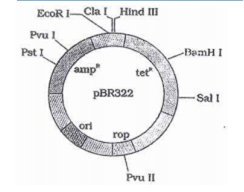 Multiple Choice Questions
Multiple Choice QuestionsWhich of the following is not a feature of the plasmids?
Circular structure
Transferable
Single stranded
Single stranded
The Taq polymerase enzyme is obtained from
Thiobacillus ferroxidans
Bacillus subtilis
Pseudomonas subtilis
Pseudomonas subtilis
DNA fragments generated by the restriction endonucleases in a chemical reaction can be separated by
centrifugation
polymerase chain reaction
electrophoresis
electrophoresis
Which of the following is not correctly matched for the organism and its cell wall degrading enzyme?
Bacteria -Lysozyme
Plant cells - Cellulase
Algae - Methylase
Algae - Methylase
The colonies of recombinant bacteria appear white in contrast to blue colonies of non-recombinant bacteria because of
Non-recombinant bacteria containing β-galactosidease
Insertional inactivation of α - galactosidase in recombinant bacteria
Insertional inactivation of α-galactosidase in recombinant bacteria
Insertional inactivation of α-galactosidase in recombinant bacteria
The cutting of DNA at specific locations become possible with the discovery of
Restriction enzymes
Probes
Selectable markers
Selectable markers
The introduction of t-DNA into plates involves
Infection of the plant by agrobacterium tumefaciens
Altering the pH of the soil, then heat-shocking the plants
Exposing the plates to cold for a brief period
Exposing the plates to cold for a brief period
The DNA molecule to which the gene of interest is integrated for cloning is called
Transformer
Vector
Template
Template
The figure below is the diagrammatic representation o the E.Coli vector pBR 322. Which one of the given options correctly identifies its certain components(s)?
Ori- original restriction enzyme
rop-reduced osmotic pressure
Hind III, Eco RI-selectable markers
Hind III, Eco RI-selectable markers
